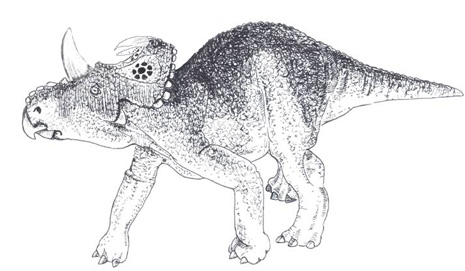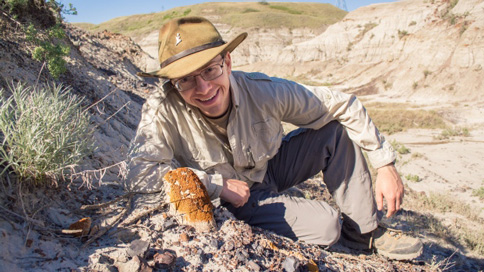“Hannah” the Horned Dinosaur
Scott Persons, a PhD student at the University of Alberta (Canada), has nicknamed a new species of Late Cretaceous horned dinosaur after his pet dog Hannah.
Palaeontologist and His Dog
The dog sometimes accompanies Scott and other members of the Earth and Atmospheric Sciences faculty on field expeditions to the Badlands of southern Alberta in the quest for fossils. The nose horn of the dinosaur was spotted by Scott sticking out of a steep cliff that led into a remote canyon back in the summer of 2015. Careful excavation revealed that most of the skull was intact and this was prepped in the field and airlifted back to the University for further study.
Scott Persons and the Nose Horn of the Dinosaur
Picture credit: Amanda Kelley
For models and replicas of horned dinosaurs and other prehistoric creatures: CollectA Prehistoric Life Models and Figures.
A Return to the Dig Site in 2016
With the start of the fieldwork season, a team of volunteers have returned to the quarry to excavate the post cranial fossil material. A number of bones have been found so far including elements from the front legs of this four-legged dinosaur. The skull shows characteristics similar to those found in two other types of horned dinosaur known from Canada. It has a large nose horn similar to Centrosaurus and the beginnings of a spiky neck frill indicating an affinity to the spectacular Styracosaurus. As the fossils have been found in a rock layer in between the strata from which Centrosaurus and Styracosaurus have been excavated, palaeontologists are suggesting that “Hannah” represents a transitional form between these two dinosaurs.
“Hannah” Will Help Fill Part of the Horned Dinosaur Family Tree

Our interpretation of “Hannah” centrosaurine in nature with forward projecting epoccipital bones as part of the frill ornamentation.
Picture credit: Everything Dinosaur
A formal scientific paper will be published and this dinosaur will be given a binomial scientific name, but for the time being, Hannah the dog has a dinosaur named after her.
Visit the Everything Dinosaur website: Everything Dinosaur.


